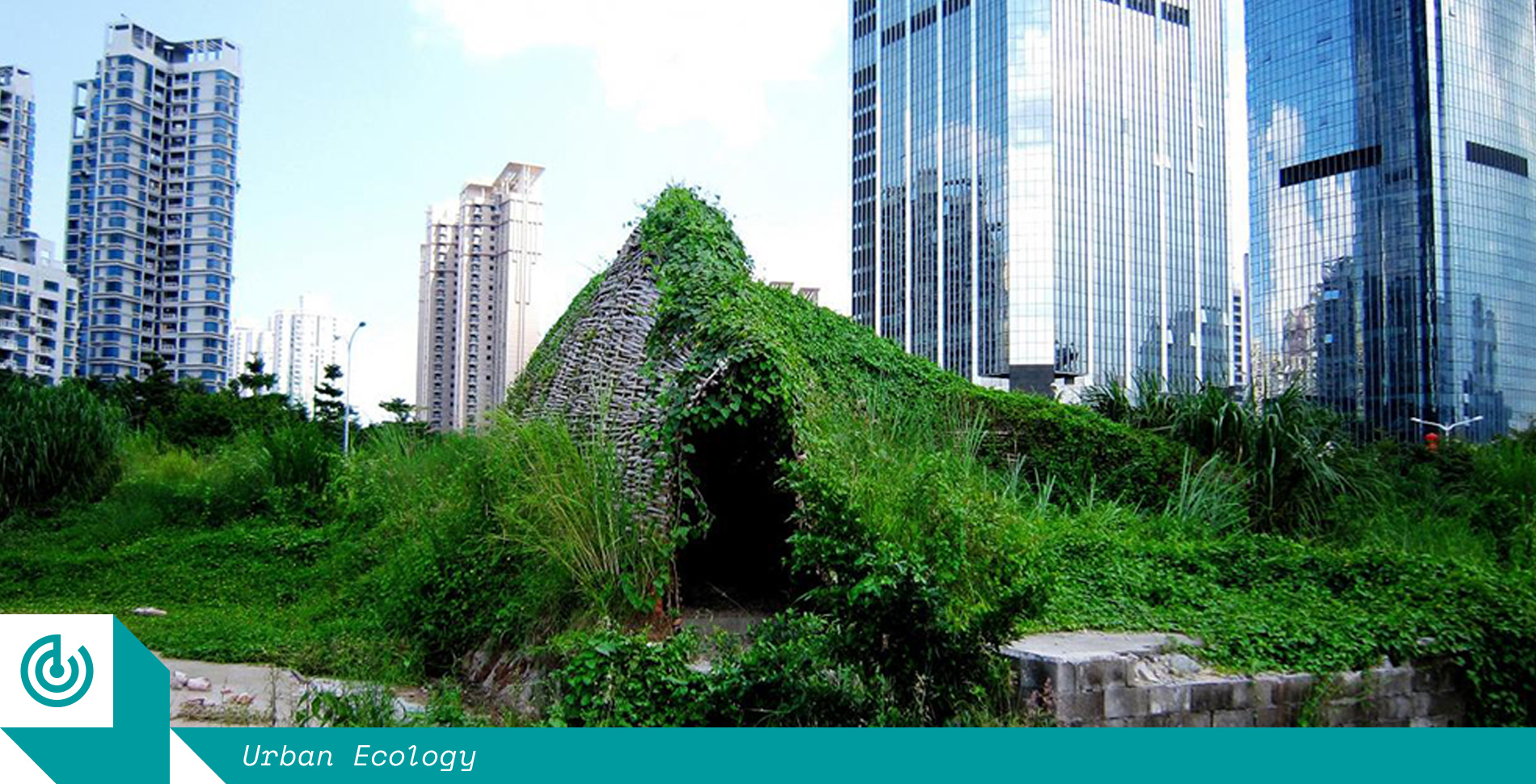
Urban ecology: Design for living systems (part 1/2)
Can we design our cities as living systems, in productive harmony with the environment? An urban ecologist, planner, landscape architect and Aboriginal architect join us to discuss the challenges and opportunities of an ecological approach to city-making.
On 21 March 2017, Foreground hosted a public forum on urban ecology at the National Gallery of Victoria. Set against a dawning realisation in Australia and elsewhere that a healthy environment and healthy communities are largely one and the same thing, the forum set out to address some pressing questions for our cities. How can we achieve the twin goals of sheltering and supporting our burgeoning communities, while also protecting ecological diversity for future generations? What is preventing a more wide-scale adoption of the principals of urban ecology among our governments and the communities they represent? Can design contribute to help instil this new ecological paradigm, bridging the gap between people, plants, animals and the landscape?
The forum explored these questions through the eyes of four people who are deeply committed to the development of our urban environments through a better understanding off, and interaction with, natural systems: Amy K Hahs, an urban ecologist, Rueben Berg, Director of Indigenous Architecture and Design Victoria, Dr Adrienne King, a planner and academic, and Ron Jones, a landscape architect who regularly consults to both state and local governments on planning policy and built projects.
Below is the first part of a two-part abridged and edited transcript from the public panel discussion that followed the speakers’ presentations. For those interested in hearing the discussion in its entirety, the first part of the full audio recording of the panel talk can also be found above.
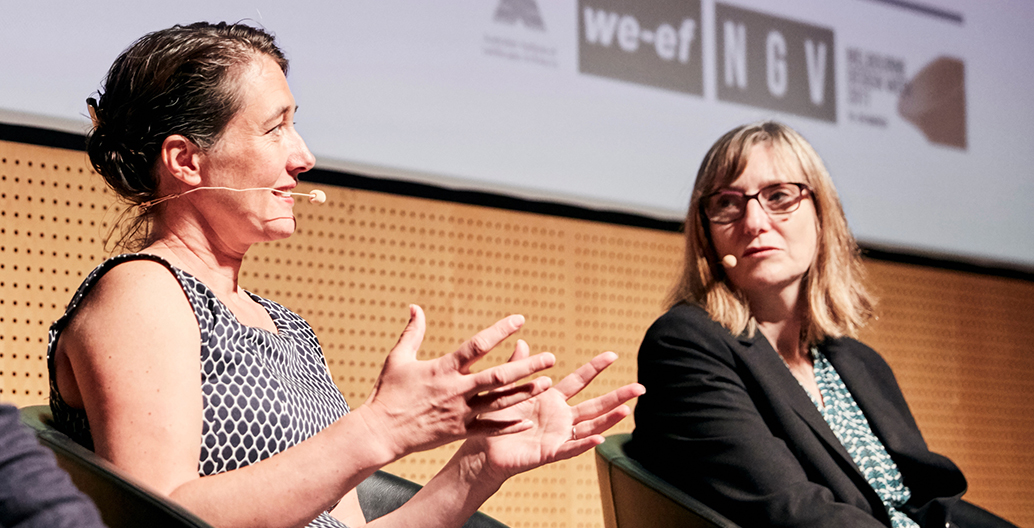
Amy K Hahs, left, speaking at the Urban Ecology panel
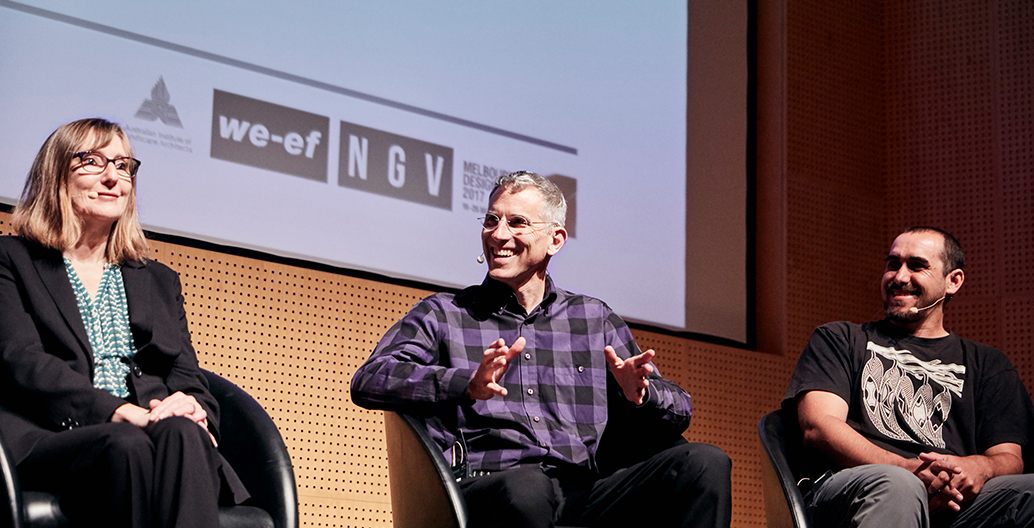
Ron Jones, centre, speaking at the Foreground Urban Ecology panel at the National Gallery of Victoria.
Maitiú Ward: At the start of the day, I described this Urban Ecology Forum as an opportunity to consider what opportunities might exist for design to help facilitate this knew ecological paradigm we’ve all been talking about. But it seems we keep moving further and further away from a conversation about design, and the person who I thought would potentially champion it, Ron, has completely scuppered that plan! So perhaps I’ll start with you Ron, is this really a question about design? Does design have a value in this conversation?
Ron Jones: Well, it’s nice to know that I’ve accomplished something today. I think so yeah, design isn’t just about the details of an end product. Design is also part of the process in terms of thinking about potentials, exploring opportunities, so yes it absolutely has a role in the process. It isn’t necessarily about coming up with projects that you can take gorgeous pictures of and publish on Foreground.
We don’t know what the city is going to look like in the future if we seriously respond to objectives to make it a healthier ecology. So how do you work out what it is going to look like? It’s a process of exploration, testing alternatives, seeing how they work, how they look, how they interact with other things, and that’s a design process. And it’s not just a matter of working out the objectives and policies – it’s actually working out how it translates into reality, so how is it not designed?
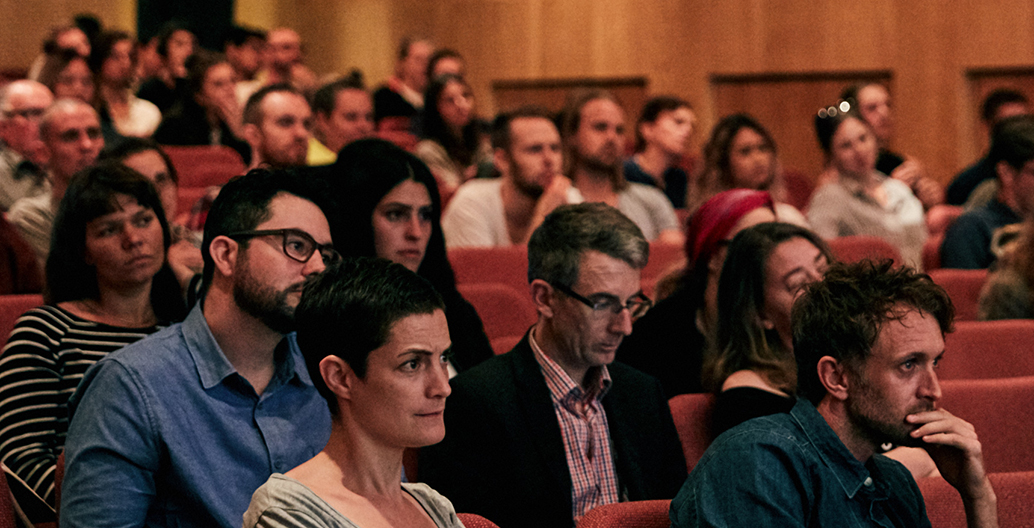
Attendees at the Urban Ecology forum.
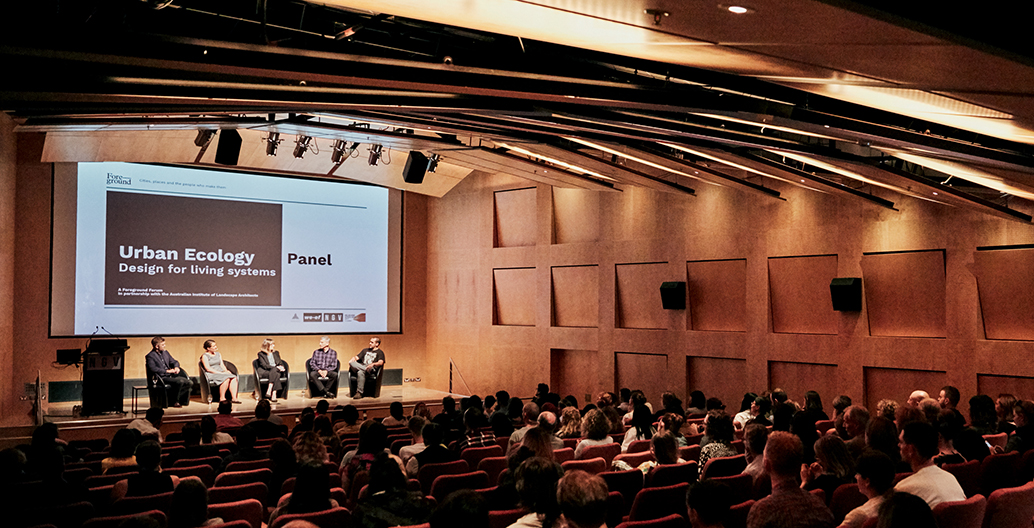
The Urban Ecology: Design for Living Systems panel at the National Gallery of Victoria.
Maitiú Ward: You referenced Denton Corker Marshall’s blue stone pavers [developed by the architects for Melbourne’s City Square, but which are now used all over the city], and to me, that absolutely seems like a designed outcome because it is an artefact. And then we also talked a little bit about [the City of Melbourne’s] Urban Forest Strategy that to me seems more about a policy-making decision, a planning decision. Where is the design in the Urban Forest Strategy?
Ron Jones: Well, I think it is probably not there, I think it provides a spring point for design probably, and to a certain extent I think that the Urban Forest Strategy is more policy than a strategy. It sets out aims and objectives and targets, and it doesn’t really deal with that issue of barriers. It was probably a political thing in terms of getting acceptance for the Urban Forest Strategy. But if you want to actually achieve these targets of increased tree canopy in the city, that means you’ve got to systematically remove parking spaces from the city streets to make more spaces for tree planting. Then the next stage of looking at possible ways of delivering that involves a design exercise of looking at the alternatives and seeing what actually works.
Maitiú Ward: Is it important that there is a design intelligence at that very early policy stage in the mix, or is it not necessary ultimately?
Ron Jones: I think it’s important, and I actually was involved to a certain extent, I was mostly just editing after spending most of my life writing and reading and editing rather than designing. So I helped edit the city Urban Forest Strategy. I like to think that there was some design intelligence brought to bear even in that limited capacity and I know there were other designers involved in putting it together, other landscape architects like Jenny Rayment. But that document involves a process of thinking about design and then stepping back from design, which is another important thing to realise.
I guess in design practice that it isn’t always a one-way process of constantly focusing in on more and more and more detail in the built product at the end. There is also an important aspect in the design process of thinking about design and then drawing back to broader principles, and I think that’s probably a weakness in the profession too, that there aren’t that many people who are good at it.
Maitiú Ward: Step back and think strategically.
Ron Jones: Yeah. To think about what is, what does a design mean and abstract from that in broader principles. That’s a design thinking, but it’s a reverse design thinking.
Maitiú Ward: Amy, you work as an urban ecologist, do you see a value for, say, landscape architecture expertise in your work?
Amy K Hahs: Absolutely. So when I started in urban ecology it was doing research and understanding how cities affect biodiversity. But then when you think about, “Well, how can I change how cities affect biodiversity?”, then landscape architecture is a profession that offers enormous opportunity. And I agree with the importance of that reflective practice after a project is completed. So Zoe’s in the audience, the landscape architect I worked on with some of the examples I gave, and one of the benefits that Zoe and I were able to experience was that after the project was delivered our conversation continued.
And we actually learnt just as much after the project as during it, and we were able to advance to a better starting point for the next project. As someone who wasn’t involved in the Urban Forest Strategy but has looked at it quite closely, I would say that my impression is that it gives a very nice roadmap for how to approach the design process. What are the important elements to include, including the input of people but also thinking about succession, and that landscapes aren’t static, they change over time. And if we want them to look the way they do now or look a certain way in the future we need to embed that into design and planning. So I think one of the strengths of the Urban Forest Strategy is saying we do value these leafy street canopies, so how are we going to protect that, and look after that and make sure it doesn’t fall away before it’s replaced again?
Maitiú Ward: We talked earlier about this idea of urban ecology as almost being a bit of an oxymoron. We’ve established that there is biodiversity in our cities, but is there a place in our cities where biodiversity is, and biodiversity isn’t?
Amy K Hahs: That’s why I like Ron’s presentation because basically biodiversity can live anywhere, so there is even bacteria on the ocean floor next to volcanic vents that are really hot and cities, even if we are not planning for biodiversity, biodiversity is there. It’s just whether or not we want to recognise and embrace it, or whether we would rather it was something different. So I think when we are thinking about cities, if we want to really have a sense of identity for our city, and a sense of belonging, then this feeds into Rueben’s presentation. It’s really about saying what is important to us in our city. What’s the story we want to tell with our biodiversity, and then starting to work out how do we actually get to the point of telling that story well. And I think that’s where design is absolutely essential, in telling the story.
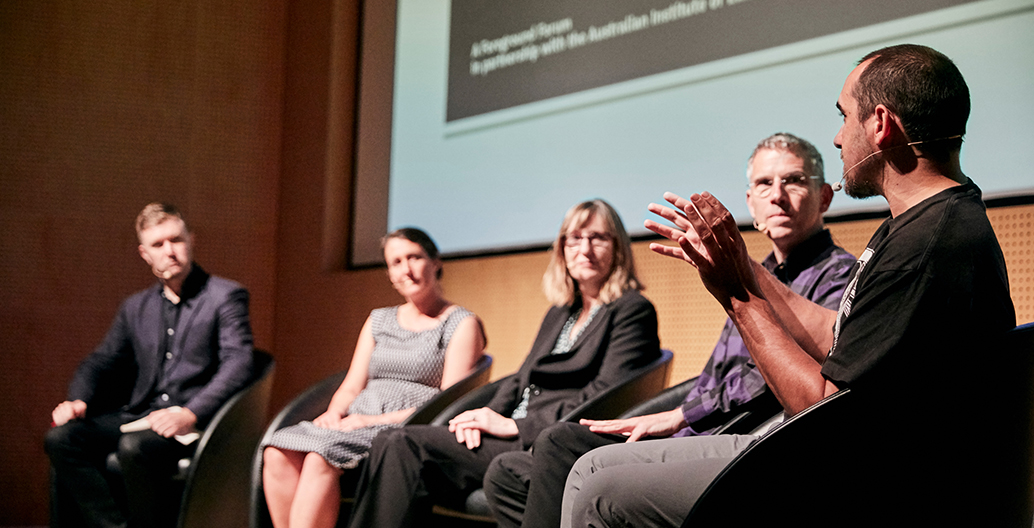
Rueben Berg, right, speaking at the Urban Ecology panel
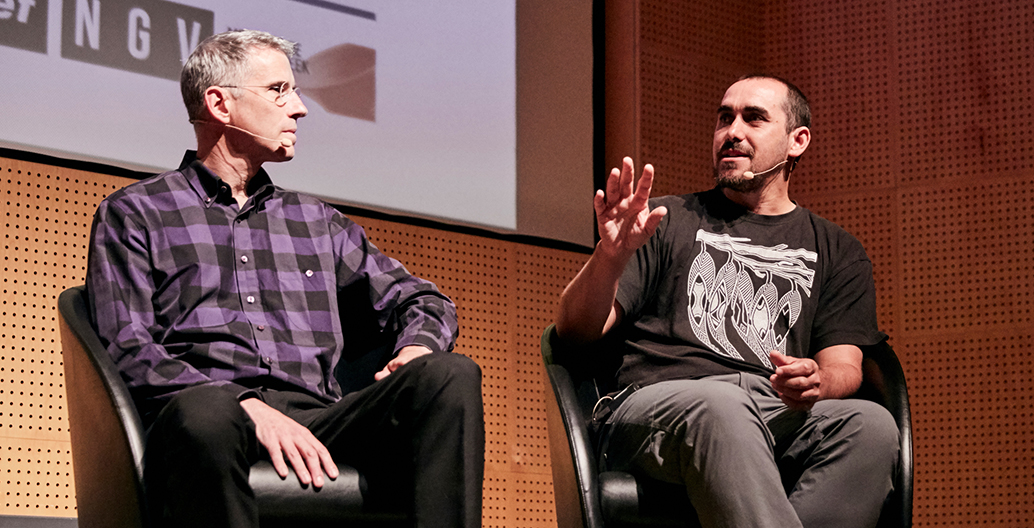
Rueben Berg, right, speaking at the Urban Ecology panel
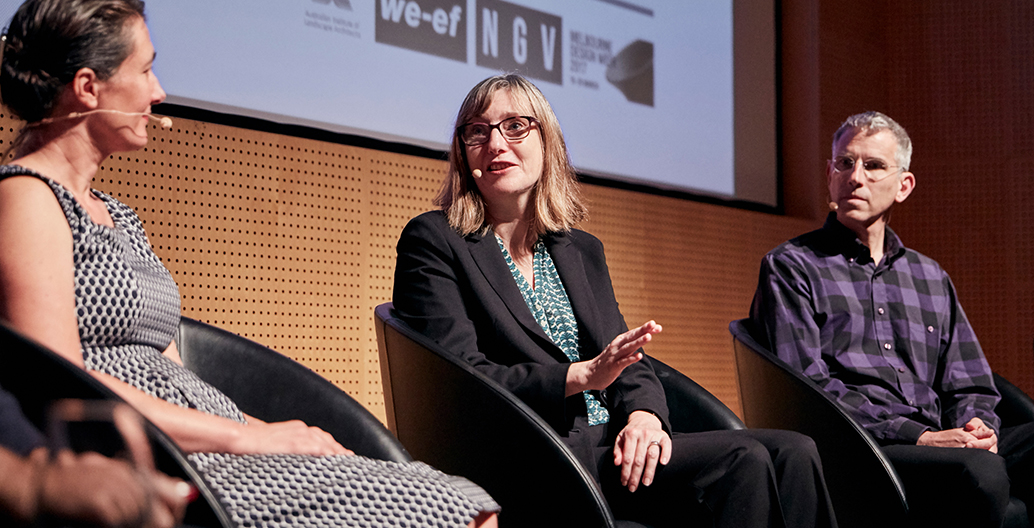
Dr Adrienne Keane speaking at the Urban Ecology panel
Maitiú Ward: It’s probably a good opportunity to throw to you Rueben. How could an acknowledgement of the city as an Aboriginal place influence design? Is this something we are likely to see change the look and feel of the city, or is it something a little bit more ephemeral?
Rueben Berg: It’s going to be hopefully in the look and feel and the way that we’re building all elements of the city. I think that when we think about this idea of trying to return the city to what it was once before as some natural untouched wonderland, that we need to recognise that it wasn’t an untouched place; that we are talking about returning it to a place that was already heavily manipulated by Aboriginal people. That the landscape that was here 200 years ago was not untouched, it was heavily touched but in a way that enabled things to work in balance. That it’s not returning it to some untouched thing, that it is a place where people were, and that’s one of those elements that we need to be considering when we are talking about how we’re reshaping our places.
You talked before about what good design is and does that have an impact on this idea of urban eco-cities. And I think that to me good design is really taking into account all the different factors that are pushing and pulling on a project, and really understanding them and working out what thing best meets all those different things that push and pull.
And that involves lots of compromise, and I think at the moment in the design process things like ecology are not at the top of the list of what people are considering… it’s not even being considered as part of that compromise, it’s just forgotten about. Part of what this whole exercise hopefully will be able to do is raise awareness with designers that it should be something they consider as one of those factors.
Because that’s what design is, it’s about choices. I’m also interested in making sure that an understanding of Aboriginal culture is one of those design elements. And as far as what that looks like, sometimes the outcome is exactly the same as it would have been otherwise. But it’s the process and what you did to prioritise it that leaves a meaningful outcome.
Maitiú Ward: Adrienne, I was slightly horrified to hear you point out that that ecological thinking isn’t present at all at a strategic level. In the New South Wales state government for example, but seemingly nationally too. And part of the problem there is this issue around cultural values and expectations determining the outcome. Is that lack of cultural awareness of these issues a problem for planners?
Dr Adrienne Keane: For sure. And I would not like to even suggest that there aren’t many fantastic people at all agencies and all levels of government working really, really hard to ensure biodiversity and urban ecology and all the fabulous things that we need in our cities. I think the big challenge is the complexities around the decision-making when it comes to competing interests. And so we see in cities at the moment, there just seems to be this drive for development, drive for infrastructure, and that’s the main thing. Take New South Wales’ 1979 Environmental Planning and Assessment Act; it was environment first, the objectives of the act were all about environment and sustainability. It was a really amazing approach. It’s been amended so much now and most of those things are about enabling development. We have all different types of development exempt from complying… things that get state significant infrastructure, state significant development, this development that development. And the priority is development, and everything else is circumvented.
And planners don’t work to circumvent. Planners themselves, the ideology behind planning is a better outcome. And yet the translation, when it goes into legislation, is that we get the politics that are also involved. Or decisions get taken out of processes and overcome by political decisions, and those decisions aren’t made by planners, and they are not made by the community, they are made by a select few people. And the system allows that to happen.
In New South Wales, they don’t actually have to explain why they’ve refused or approved a development where the council planner has recommended the opposite. So with all the wonderful work that is done by our scientists, and the planners trying to work with the community and develop strategies to guide our planning, and to enable good design thinking, unless there is that change in politics to not make development first, then everything else that we discussed doesn’t progress.
Maitiú Ward: Are planners doing enough to advocate on that front for a greater understanding of these ecological considerations?
Dr Adrienne Keane: Yeah, isn’t that a great question. I think in the past planners have really seen themselves as public servants, if you like. And when you think about who’s talking about cities you actually don’t hear many planners speak, but I think that’s changing. Architects speak a lot, but you don’t often hear planners speak, but now we’re hearing planners speak, we are hearing planners speak even from university positions for example, or the Planning Institute of Australia. Or in New South Wales, we have a community group that’s supported by lots of planners all around the place called the Better Planning Network. And they are advocating, so there is real advocacy. And of course, planners if they are employed by government or if they are engaged by say a court they have to serve the government or have to serve the court. And what we do is provide the evidence, but in the end, the planners aren’t making the decision.
Maitiú Ward: Ron, you began your presentation there with a discussion of green as a fluffy marketing tool. Do you think this idea of a symbolic embrace of urban ecology considerations or sustainability serves much of a purpose?
Ron Jones: I think it’s a mixed bag. I think that there is a lot of importance in education, a lot of importance in showing that a project actually accomplishes something at times. Examples of ways forward are really important and if people don’t recognise something as being an example of a way of dealing with an issue why would they take it up? I mean if you don’t in some way identify a project as having ecological value or value in contributing to sustainability then its role, its value as an exemplar model, is not that great. On the other hand, I think that when you start wearing things on your sleeve that it becomes potentially something that can be abused.
I also think that not everybody wants to be living in a house that looks like they’re 70s flower children, some people just want an ordinary looking house that works well. And they don’t want green roofs, they just want a nice house.
Maitiú Ward: Is it possible from that perspective for designers, landscape architects, and architects to work, to shift cultural expectations, to shift cultural values? Is it necessary for them to engage in that symbolism to achieve those kinds of shifts or can it be done in other ways?
Ron Jones: It can be done through advocacy, it can be done by pointing out projects that do well, that people may not notice. That, oh yeah, that house has got solar panels on the roof you can’t see, it’s got a 10,000-litre rainwater tank that you can’t see, it’s got a ground source heat exchange system powering the heating and cooling that you can’t see, and if you just walk along the street it looks ordinary. That can be pointed out and celebrated without the project itself doing that job.
So there is that role of identifying and promoting projects that work well, that’s really important. One of the issues is that the role of professional designers across the metropolitan area is just minuscule. A tiny, tiny, tiny fraction of the houses that are built have had an architect within smelling range, and probably the fraction of landscapes, gardens and things is even smaller. So, there’s a really important role in setting an example with projects, designing things that can be reproduced. And I think one of the issues we have in our design culture is we design everything to be special rather than to be reproducible.


